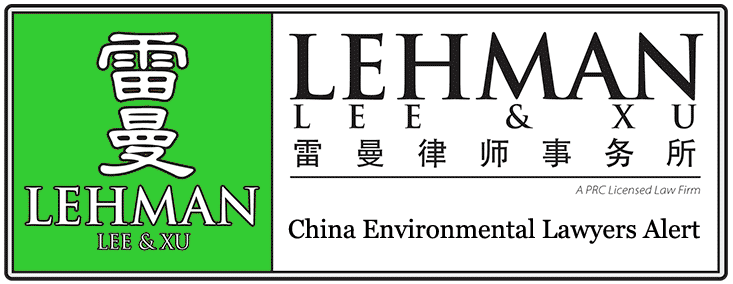

 |
|
LEHMAN, LEE & XU China Lawyers |
|
China Environmental Lawyers Alert |
|
Dec. 04, 2015
|
The China Law News keeps you on top of business, economic and political events in the China. |
|
|
|
In the News |
Will China’s New Air Law Solve its Pollution Crisis? |
The recent news that China has been underreporting its already globe-leading coal consumption by nearly 20 percent for the last decade underscores the scale of its air pollution crisis. In 2014, 90 percent of 161 monitored cities failed to meet China’s air quality standards due primarily to emissions from coal-fired power plants. Skyrocketing air pollution levels have led to a public outcry, which in part manifested in the viral spread of the documentary, Under the Dome, by well-known journalist Chai Jing earlier this year. The Central Party has responded to this pressure by passing new amendments to its Air Pollution Prevention and Control Law that will be made effective on January 1, 2016. This new legislation provides a legal foundation upon which to improve air quality. But while the amendments propose several changes that reflect new political will to clear the airways, there are still serious gaps in regulatory and enforcement capacity, said Li Shuo, senior climate and energy policy officer at Greenpeace East Asia at the Wilson Center on September 11. China’s environmental laws have historically served “more [as] political statements than as a tool to effectively utilize [in addressing issues],” he said. Three Major Changes According to Steve Wolfson, a senior attorney at the U.S. Environmental Protection Agency, the 2015 amendments to the Air Pollution Prevention and Control Law are the latest in a sequence of reforms, beginning in 2013 with China’s Clean Air Action Plan. They also follow on China’s Intended Nationally Determined Contributions, which will feed into the UN climate summit in Paris this fall. These commitments are a “recognition of the growing synergies from moving away from an economy that is unbalanced…to a more balanced and sustainable economy in the long-term,” said Wolfson. The amended law includes three major changes: an explicit emphasis on the link between public health and air pollution, a call for more decentralized emissions governance, and the introduction of new mechanisms for controlling sources of air pollution. Addressing Public Health Most notably, the amended law, for the first time, explicitly places human health at its foundation. The very first provision includes “safeguarding public health,” a clear acknowledgment to the public that the government is aware of the growing environmental health concerns of its citizens. The former law did not explicitly mention the connection between public health and environmental protection. Emissions Prevention and Control Previously, the air law only set provisions for the control of nitrous oxide and sulfur dioxide. The new amendments have expanded the list of pollutants to also include particulate matter, volatile organic compounds, and greenhouse gases. These pollutants were previously governed by various state agencies, and the new law calls for integrated control under one national agency. Regional Air Quality Management The amendment also establishes a new framework for regional air quality management and coordination. The provisions call for state coordination of regional air pollution prevention and control. The Ministry of Environmental Protection (MEP), which is under the authority of the State Council, is charged with identifying key regions for air pollution prevention and control. The local governments, along with the MEP and relevant bodies of the State Council, will then select a governing body to create a plan for mitigation and control of air pollutants, based on regional economic development and capacity. The selected governing body will coordinate regional air monitoring and standards setting. Cities that fail to meet national air quality standards will be required to submit a plan for achieving them. Additionally, city and municipal governments will be responsible for submitting an annual report and announcing efforts to the public. In effect, the local government within each province will be given the jurisdiction and responsibility to improve its air quality, and throughout the process must maintain transparency with the public. However, the MEP will monitor the enforcement and performance of these regional plans. Lessons Learned From the Clean Air Act China is not alone in its plight. Choking pollution in U.S. cities like Los Angeles set the stage for the1963 Clean Air Act. In 1970, the bill was further strengthened and the Environmental Protection Agency was created. It was later revised to include National Ambient Air Quality Standards in 1990. Through U.S. government and non-government exchange, China has drawn lessons from this experience. In November 2008, China’s MEP held a workshop in Beijing with U.S. air pollution experts. Afterwards, a team of NGOs led by the Natural Resources Defense Council, Regulatory Assistance Project, and Energy Foundation, prepared a set of recommendations for amendments to the air pollution law. The same team, along with additional Chinese universities, NGOs, and local environmental protection bureaus, made a similar set of recommendations in 2015, and some of their suggestions are reflected in the amendments coming in January. Under the Clean Air Act, the EPA has the authority to set primary air quality standards that are deemed necessary to protect human health, including the health of sensitive populations. The law outlines the impacts of urbanization and industrial development on human health and declares the purpose of the act is to protect air quality so as to “promote the public health and welfare and the productive capacity of its population.” However, there are major differences between the Clean Air Act and China’s air law. The Clean Air Act is a substantial legal document which offers detailed parameters and mandates for air standards, pollution modeling, and monitoring. It also offers a concrete framework for a permit system. In contrast, China’s revised Air Pollution Action Plan lays down principles and broad mandates, but very few regulatory mechanisms for emissions control, leaving more room for interpretation and little guarantee of enforcement. The Path to Blue Sky Days While the revisions to China’s Air Pollution Action Plan are noteworthy, as the revelation about coal consumption demonstrates, implementation will be the key challenge. As the revised law shifts the responsibility of regulating air pollutants to local governments, Beijing needs to create incentives that push officials toward compliance through planning and financial assistance. This also requires clear incremental targets for mitigating emissions and controlling pollutants. Cooperation between the MEP and National Health and Family Planning Commission will also need to be improved to fulfill the legislation’s new focus on public health, including better data sharing on diseases and emissions. “Air pollution is a cross-sectoral issue,” said Ranping Song, developing countries climate action manager at the World Resources Institute. China must have a more dynamic system that allows for citizen participation, said Shuo. He cited the explosions at Tianjin earlier this year, which raised questions about negligence in the issuing of permits and regulation, as an example of the discrepancy between law “on paper” verses law that is legitimate and actually followed. “We need more weapons in the arsenal,” Shuo said. Only with stronger legislation, greater citizen participation, and policy coordination can blue sky days return to China. http://www.newsecuritybeat.org/2015/11/chinas-air-law-solve-pollution-crisis/ |
|
|
|
|
| Proud Member of |